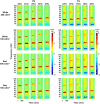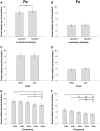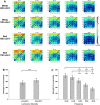Optimal flickering light stimulation for entraining gamma rhythms in older adults
- PMID: 36114215
- PMCID: PMC9481621
- DOI: 10.1038/s41598-022-19464-2
Optimal flickering light stimulation for entraining gamma rhythms in older adults
Abstract
With aging, optimal parameters of flickering light stimulation (FLS) for gamma entrainment may change in the eyes and brain. We investigated the optimal FLS parameters for gamma entrainment in 35 cognitively normal old adults by comparing event-related synchronization (ERS) and spectral Granger causality (sGC) of entrained gamma rhythms between different luminance intensities, colors, and flickering frequencies of FLSs. ERS entrained by 700 cd/m2 FLS and 32 Hz or 34 Hz FLSs was stronger than that entrained by 400 cd/m2 at Pz (p < 0.01) and 38 Hz or 40 Hz FLSs, respectively, at both Pz (p < 0.05) and Fz (p < 0.01). Parieto-occipital-to-frontotemporal connectivities of gamma rhythm entrained by 700 cd/m2 FLS and 32 Hz or 34 Hz FLSs were also stronger than those entrained by 400 cd/m2 at Pz (p < 0.01) and 38 Hz or 40 Hz FLSs, respectively (p < 0.001). ERS and parieto-occipital-to-frontotemporal connectivities of entrained gamma rhythms did not show significant difference between white and red lights. Adverse effects were comparable between different parameters. In older adults, 700 cd/m2 FLS at 32 Hz or 34 Hz can entrain a strong gamma rhythm in the whole brain with tolerable adverse effects.
© 2022. The Author(s).
Conflict of interest statement
The authors declare no competing interests.
Figures





References
Publication types
MeSH terms
LinkOut - more resources
Full Text Sources
Other Literature Sources

